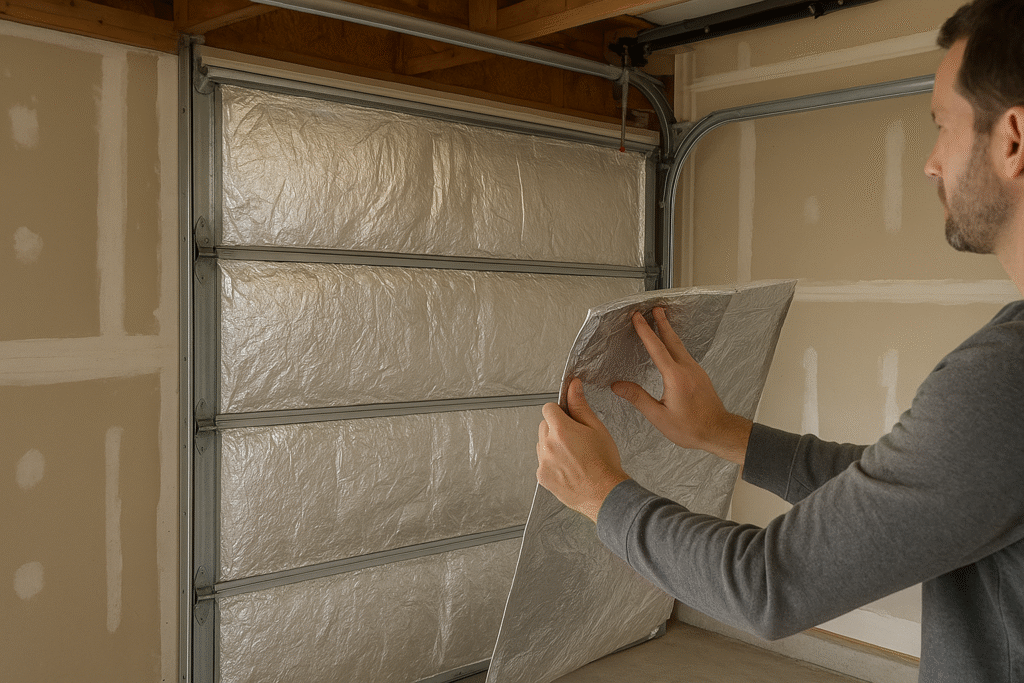Introduction: Understanding Garage Door Insulation
A garage is more than just a place to park your car — for many homeowners, it’s also a workspace, storage area, or even an extension of their living space. However, because garages are often not connected to a home’s main heating or cooling system, they can easily become too hot in summer or too cold in winter. That’s where garage door insulation comes in.
Garage door insulation helps create a barrier that reduces heat transfer, keeps the indoor temperature stable, and prevents outside noise from entering. It can make your garage more comfortable to use throughout the year while lowering energy costs. By insulating the door, you reduce the amount of heat escaping during cold months and keep excess heat out during warmer ones. It’s one of the simplest yet most effective home upgrades to improve energy efficiency, enhance comfort, and protect your belongings stored in the garage.
What Garage Door Insulation Does for Your Home?
Adding insulation to your garage door can have a surprisingly big impact on your home’s overall comfort and energy performance. When your garage door is insulated, it prevents outside air from leaking in and conditioned air from escaping. This helps maintain a more consistent temperature, reducing the strain on your home’s heating and cooling systems.
If your garage is attached to your house, the temperature inside can affect the rooms next to it. Insulating the garage door acts as a buffer, making your entire home more energy-efficient. You’ll notice fewer drafts and a more stable indoor climate. In addition, garage door insulation can reduce outside noise — such as traffic or neighbors — making your garage and nearby rooms quieter.
Beyond comfort, insulation also helps extend the lifespan of your garage door by reducing moisture buildup and minimizing the wear caused by temperature changes. It’s an upgrade that adds both comfort and value to your home.
Different Types of Garage Door Insulation Materials
Choosing the right insulation depends on your needs, budget, and the type of garage door you have. Below are the most common types used in residential projects:
- Foam Board Insulation – Made from rigid panels, foam board is lightweight and effective for metal doors. It provides excellent thermal resistance without adding too much bulk.
- Reflective Foil Insulation – This type uses a reflective aluminum layer to bounce radiant heat away from the garage, making it ideal for homes in hot climates.
- Fiberglass Insulation – Commonly used in walls and attics, fiberglass also works well for garage doors. It’s flexible, affordable, and provides good thermal and sound insulation.
- Spray Foam Insulation – Spray foam fills every gap and crack, offering one of the best seals for temperature control and noise reduction.
- Polystyrene Insulation – A rigid foam material that provides solid insulation performance at a reasonable cost. It’s often pre-fitted in insulated garage door panels.
- Polyurethane Insulation – Known for its high R-value, polyurethane is used in premium garage doors. It bonds directly to the door panels for excellent strength and energy efficiency.
- Cellulose Insulation – An eco-friendly option made from recycled materials, cellulose helps regulate temperature and absorb sound.
Each material serves a specific purpose, and choosing the right one depends on your garage setup, climate, and desired level of insulation.
How to Choose the Right Garage Door Insulation?
When selecting garage door insulation, think about your local climate first. If you live in a hot area, reflective foil insulation may be best for blocking heat. In colder regions, foam or fiberglass options might be more effective for trapping warmth.
Another important factor is the R-value, which measures how well insulation resists heat flow. A higher R-value means better insulation. While thicker materials usually have higher R-values, you also need to make sure they fit your garage door type.
Budget and usage matter too. If you spend a lot of time in your garage — for example, using it as a workshop or gym — investing in higher-quality insulation will pay off in comfort and savings. If your main goal is just to reduce temperature extremes slightly, a mid-range option will work fine.
DIY Garage Door Insulation vs. Professional Installation
When it comes to installing garage door insulation, you have two main choices: do it yourself or hire a professional.
DIY insulation kits are easy to find and can save you money. They typically come with pre-cut panels or rolls that you attach directly to your garage door. This approach is suitable if you’re handy with tools and have a standard-sized door. However, it’s important to measure accurately and seal every gap to ensure effective insulation.
Professional installation costs more but guarantees a better fit and longer-lasting results. Experts can recommend the best materials based on your climate, door type, and home design. They also ensure that your garage door balance, weight, and safety mechanisms remain unaffected after insulation.
If you’re unsure, consider a hybrid approach: do the preparation yourself, then have a professional handle the final installation. That way, you balance quality and cost effectively.
Step-by-Step Overview of the Insulation Process
The process of insulating a garage door is simple but requires attention to detail. It starts with a clean surface — the door should be free of dust, grease, and debris. Next, measure the panels carefully and cut your insulation material to size.
Attach the insulation using adhesive strips, clips, or specialized fasteners depending on the material type. Make sure each section fits snugly without gaps. If you’re using reflective foil or foam boards, sealing the edges with tape helps prevent air leaks.
Finally, check the garage door’s balance and motion. The insulation adds some weight, so adjusting the spring tension might be necessary. Properly installed garage door insulation should look neat and not interfere with the door’s operation.
How Garage Door Insulation Impacts Energy Efficiency?
Insulating your garage door can make a measurable difference in your home’s energy performance. When less heat escapes in the winter and less enters during summer, your heating and cooling systems run more efficiently. That means lower utility bills and less energy waste.
This improved energy balance also reduces your carbon footprint. Homes with insulated garages often feel more comfortable because they eliminate the “cold room next to the garage” effect. By controlling temperature swings, garage door insulation helps maintain a more stable indoor environment across the whole house.
Even if your garage isn’t heated or cooled, insulation acts as a buffer, helping your HVAC system perform better and last longer.
Maintenance Tips for Insulated Garage Doors
Once your garage door is insulated, maintaining it is easy. Regularly inspect the panels and seals for any damage or wear. Clean the door’s surface gently to prevent dust buildup on the insulation.
If you notice gaps or loose edges, reapply adhesive or fasteners as needed. Lubricate the hinges and tracks occasionally to ensure smooth operation, since added weight from insulation can affect movement over time.
During seasonal changes, check for condensation or moisture buildup, especially if you live in humid climates. Keeping the insulation dry ensures it remains effective and durable.
Signs Your Garage Door Needs Better Insulation
Even good insulation can wear out or become less effective over the years. If you start feeling temperature swings inside the garage, notice higher energy bills, or hear more outside noise than usual, it may be time to upgrade.
Another sign is visible damage — such as sagging, peeling, or compressed insulation panels. Also, if your garage feels drafty or damp, the existing insulation may have gaps or moisture issues. Replacing or upgrading your garage door insulation restores comfort and helps maintain energy efficiency throughout the year.
Conclusion: Why Garage Door Insulation Is a Smart Long-Term Investment?
Garage door insulation is one of those upgrades that quietly pays off in comfort, savings, and home value. It keeps your garage usable year-round, protects stored items from extreme temperatures, and helps your home’s energy system work more efficiently.
Whether you choose foam, fiberglass, or reflective insulation, the benefits go beyond temperature control. You’ll enjoy less noise, fewer drafts, and better protection for your door and its components.
In short, garage door insulation is a practical improvement that makes your home feel warmer in winter, cooler in summer, and more comfortable all year long — a smart, lasting investment every homeowner should consider.




